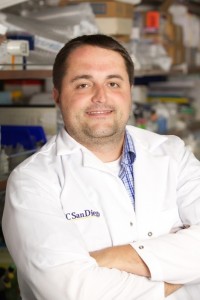Mechanical Signaling in Epithelial-Mesenchymal Transition
Mammary epithelial cells (MECs) are classically known to respond to differences in static extracellular matrix (ECM) stiffness and resemble a mesenchymal, more malignant state lacking any polarized acinar structure on stiffer ECM, i.e. Epithelial-Mesenchymal Transition (EMT). While this is akin to the stiff mammary tumors that one can detect with manual palpation, breast cancer fibrosis is a dynamic process that results in matrix stiffness increasing from normal ~150 to stiff 5000 Pascals (Pa) over months to years as a result of enhanced collagen expression and lysyloxidase crosslinking. I will present data on our new understanding of a molecular mechanism used by MECs interpret stiffness changes in which the EMT marker Twist changes its nuclear localization based on binding to GTPase Activating Protein (SH3 Domain) Binding Protein 2 (G3BP2). G3BP2 suppression drives tumorigenesis in mice whereas higher expression is correlated with recurrence free survival in women (Wei et al, Nature Cell Bio 2015). I will also describe our efforts to more accurately mimic the onset of tumor-associated fibrosis using dynamic methacrylated-hyaluronic acid (MeHA) hydrogels, whose stiffness that can be modulated from “normal” 100 Pa to “malignant” 5000 Pa, utilizing a two step polymerization process. Mammary epithelial cells cultured on 100 Pa MeHA hydrogels form and remain as polarized acini and then undergo EMT upon matrix stiffening to 5000 Pa. However, the degree of matrix stiffening and culture time prior to stiffening play a large role in acini transformation; increasing culture time on soft matrix prior to stiffening from 6 to 10 days delayed the onset malignant transformation by as much as 35%. EMT is independent of acinus size, cell density, and is not cell intrinsic, suggesting that individual acini respond to the stiffness but their epigenetic state and structure can protect a subset of acini from stiffening. These data indicates a more complex interplay of intrinsic ECM cues and acinar structure in regulating signaling that results in EMT and the onset of a malignant phenotype.
Bio
 Adam J. Engler is an Associate Professor of Bioengineering at UC San Diego, where he has been on the faculty since 2008. He also is a resident scientist at the Sanford Consortium for Regenerative Medicine. Dr. Engler previously trained with Dr. Dennis Discher at the University of Pennsylvania, where he earned his PhD studying how ECM stiffness regulated stem cell fate. He also did a postdoc with Dr. Jean Schwarzbauer at Princeton University’s Department of Molecular Biology. His current research focuses on how physical and chemical properties of the niche influence stem cell function and misregulate muscle function and heart performance during disease and aging. His lab makes natural and synthetic matrices with unique spatiotemporal properties to mimic niche conditions to improve stem cell behavior and commitment in vitro for their therapeutic use in vivo. His lab also studies these processes in vivo with rapidly aging model systems including Drosophila. Dr. Engler was the 2008 recipient of the Rupert Timpl Award from the ISMB. He was also a recipient of an NIH Innovator Award, Y.C. Fung Award from ASME, Rita Schaeffer Award from BMES, and was the inaugural recipient of the Renato Iozzo Award from ASMB.
Adam J. Engler is an Associate Professor of Bioengineering at UC San Diego, where he has been on the faculty since 2008. He also is a resident scientist at the Sanford Consortium for Regenerative Medicine. Dr. Engler previously trained with Dr. Dennis Discher at the University of Pennsylvania, where he earned his PhD studying how ECM stiffness regulated stem cell fate. He also did a postdoc with Dr. Jean Schwarzbauer at Princeton University’s Department of Molecular Biology. His current research focuses on how physical and chemical properties of the niche influence stem cell function and misregulate muscle function and heart performance during disease and aging. His lab makes natural and synthetic matrices with unique spatiotemporal properties to mimic niche conditions to improve stem cell behavior and commitment in vitro for their therapeutic use in vivo. His lab also studies these processes in vivo with rapidly aging model systems including Drosophila. Dr. Engler was the 2008 recipient of the Rupert Timpl Award from the ISMB. He was also a recipient of an NIH Innovator Award, Y.C. Fung Award from ASME, Rita Schaeffer Award from BMES, and was the inaugural recipient of the Renato Iozzo Award from ASMB.
